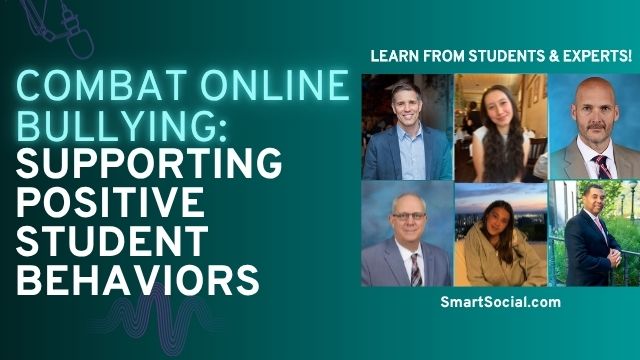Cyberbullying Signs and Prevention Tactics from 5 Experts
Green Zone App
(Click here to learn more)
Dangerous Social media challenge
(Click here to learn more)
Red Zone App
(Click here to learn more)
Gray Zone App
(Click here to learn more)

As the amount of time students spend behind a screen increases, many parents are wondering how they can protect their children from cyberbullying. Understanding the signs of cyberbullying and finding creative ways to offer support are the best ways parents can monitor and safeguard their children. However, some parents may not know how to identify the signs of cyberbullying.
We asked 5 digital safety experts to share the top signs of cyberbullying and tips parents can use to prevent, monitor, and discuss cyberbullying with their student.
1. Stay involved in every aspect of your child’s life

]Dr. John DeGarmo, The Foster Care Institute, @DrJohnDeGarmo
Bullying has changed in the 21st century with the rise of technology. Cyberbullying is the use of technology to embarrass, threaten, tease, harass, or even target another person. With the use of online technology and social networking sites, today’s bully can follow their targeted victim wherever the child may go. Today’s youth are very technologically savvy, so cyberbullying can take on many forms.
This type of bullying can be done through emails, chat rooms, social networking sites, text messages, cell phones, and even websites. There are countless ways a child can be bullied with this type of technology, and the number of ways is increasing, just as technology continues to advance. Your child may be a victim of cyberbullying if he or she:
- Becomes nervous or shows signs of anxiety when they receive a text, email, or instant message
- Is withdrawn from family and others
- Lashes out in anger towards others
- Shows signs of depression
- Tries to find excuses not to go to school
- Spends less time on/no longer the computer or other online devices
- Shows signs of suicidal thoughts or actions
- Has difficulty sleeping
- Shows changes in diet that leads to significant weight gain or loss
The most important thing you can do as a parent in protecting your student from cyberbullying is to stay heavily involved in all aspects of the child’s school life. Ask your student each day how school was. Enquire about your child’s friends.
Keep in regular contact with your child’s teachers, and ask for updates on the child’s behavior and academics. If possible, become a volunteer at the school. Not only will these strategies help monitor any possible cyberbullying behavior, you will also help your child with any academic challenges they might be experiencing. Watch for sudden mood swings that might suggest the child is being bullied, as well as signs of depression, isolation, and separation from others.
2. Provide calm and non judgmental support

Nityda Coleman, Teen Therapy Austin
Here are some warning signs that your teen may be the victim of cyberbullying:
Marked changes in behavior:
- Refusing to go to school (although cyberbullying happens online, it is most often classmates that do the bullying)
- Decreased interest in school-related activities
- Academic problems and a drop in grades
- Difficulties concentrating and making an effort in tasks at home and at school
- Increased isolation or talking to parents less often
- Dismissal of affection or praise
- Change in dress code
- Change in weight or eating habits including eating disorders
- Engagement in cutting or other forms of self-harm
- Use of negative self-talk
- Expressing anger towards peers or friends
- Increase in risk-taking behavior or putting oneself in dangerous scenarios
- Change in sleeping habits (less or more)
- Nightmares
- Increased anxiety
- Alcohol, and drug use
Emotional signs:
- Increased irritability
- Unpredictable changes in mood
- Crying spells
- Depressed mood, anxious mood, or other changes in mood
- Noticeable shift in mood after time spent online
Of course, the warning signs listed above could be attributed to a number of mental health concerns. It's important to notice how the child's mood is impacted by time online. It's even more important to listen to the verbal and nonverbal indicators that something is going wrong in your teen's world and to provide calm and non judgmental support.
3. Have open communication with your student

Glenn Allan, Allan Family Media
Some of the signs of cyberbullying are the same as in-person bullying and abuse, in particular physical and sexual abuse. One of the most obvious signs of cyberbullying is if your child becomes withdrawn and there is a drastic change in their personality.
It is much easier to observe in a child who was outgoing, and then suddenly becomes quiet, withdrawn, and avoids the computer or other devices. Depression is another tell-tale sign that a student is being bullied online, especially if they become sad, tearful, frustrated or angry after being on their computer. It's vital to have open communication with your child about who their 'cyber-friends' are. Also, relocate the family computer to a high traffic area where they can be supervised.
This may decrease their chances of coming into contact with a sexual predator or bully. Parents should also take a course on the use of the internet. Above all, your student should understand that they can always come to you and will have full support from parents and authorities.
4. Add new behaviors to your parental radar

Justin Lavelle, BeenVerified
Be on the lookout if a teen becomes sad and withdrawn, but also add to your radar new behaviors, such as a lack of interest in their phones or computers or an overly obsessive use of either.
Take notice if they become guarded or secretive about online happenings and their social profiles, or if they delete them altogether. If your child is showing one or more of the above traits, check your phone bill's call log for an increase in incoming texts and calls from new numbers on your child’s phone.
5. Remember that cyberbullying is used in conjunction with traditional bullying

Sarah Tippett, Homeschool Base
The major problem with cyberbullying is that it is used in conjunction with more traditional forms of bullying. Pictures of a kid getting beat up or made fun of may get posted on Facebook.
The next day, everyone is talking about it, which results in more online views and unwanted attention toward the victim. We need to teach students that it isn't difficult to block someone or simply turn off your device.
Cyberbullying statistics:
- About half of young people have experienced some form of cyberbullying, and 10% to 20% experience it regularly
- Only 1 in 10 teens tells a parent if they have been a cyberbully victim
- Fewer than 1 in 5 cyberbullying incidents are reported to law enforcement
- 1 in 10 adolescents or teens have had embarrassing or damaging pictures taken of themselves without their permission, often using cell phone cameras
- About 1 in 5 teens have posted or sent sexually suggestive or nude pictures of themselves to others
- Girls are somewhat more likely than boys to be involved in cyberbullying
- Over 80% of teens use a cell phone regularly, making it the most popular form of technology and a common medium for cyberbullying
- Mean, hurtful comments and rumors are the most common type of cyberbullying
- Cyberbullying affects all races
- Bullying victims are 2 to 9 times more likely to consider committing suicide
- 68% of teens agree that cyberbullying is a serious problem
- 81% of young people think bullying online is easier to get away with than bullying in person
- 90% of teens who have seen social media bullying say they have ignored it. 84% have seen others tell cyberbullies to stop
- Research presented at the 2017 Pediatric Academic Societies Meeting revealed the number of children admitted to hospitals for attempted suicide or expressing suicidal thoughts doubled between 2008 and 2015. Much of the rise is linked to an increase in cyberbullying
Sources: BullyingStatistics.org, DoSomething.org & CNN
Conclusion
Cyberbullying can affect anyone regardless of age, race, or economic status. Therefore, it's important to know the warning signs of cyberbullying, to be involved in your child's life so you can look out for the warning signs, and to have a plan if your child is being cyberbullied.
It can be hard to keep up with your child's digital life, but if they exhibit behaviors– like having anxiety when they receive a notification, being withdrawn from family and friends, lashing out in anger, finding excuses not to go to school, spending less time/no longer uses time on the computer or other online devices, having difficulty sleeping, and significant weight gain or loss– then it's important to step in, have a discussion with them, and offer a supportive environment to find a solution.
Above all else, the best thing you can do is be actively involved in your children's lives and have regular discussions about cyberbullying. Try to understand all of the different ways that people bully others online so that you can educate your children about them. Remind your children that they can always come to you or a trusted adult if they are being targeted by others online.
Additional Resources
To find out other about apps where students are chatting: Best Chat Apps: What Parents, Educators, & Students Need to Know
With so many resources available and so many people wanting to help, suicide can be prevented. Check on your friends and family members often and let them know you’re there for them. Let’s work towards getting rid of the stigma of talking about mental health.

If you or someone you know is in an emergency, call or text the Suicide & Crisis Lifeline at 988 or call 911 immediately. If you’re uncomfortable talking on the phone, you can also text HOME to 741-741 to be connected to a free, trained crisis counselor on the Crisis Text Line.
Protect your family and enter for a chance to win cool prizes
Become a member or log in to learn more on this topic
Protect your family and enter for a chance to win cool prizes

., start learning from this page to earn points!*
Hello, I'm Josh, the founder of SmartSocial.com.
Don't leave this page until you fill out our feedback form that will appear after you learn from the resources...
Become a Very Informed Parent (VIP) to get our social media suggestions in your email every Tuesday & Thursday.



Hello, I'm Josh, the founder of SmartSocial.com. Protect your family by taking my 1 minute quiz
This quiz will help you understand how safe your family is


Schools & Districts: Partner with us to protect your community online
Our remote presentations (and website) teach over a million parents and students each year how to be safe so they can shine online. We teach students how their accounts can be used to create a portfolio of positive accomplishments that impress colleges and employers.


Join Our Smart Social Podcast
each week on iTunes
With over 500 episodes, Josh Ochs interviews psychologists, therapists, counselors, teachers, and parents while showing you how to navigate social media to someday shine online.
Listen on:



.jpg)
.jpg)
.jpg)


